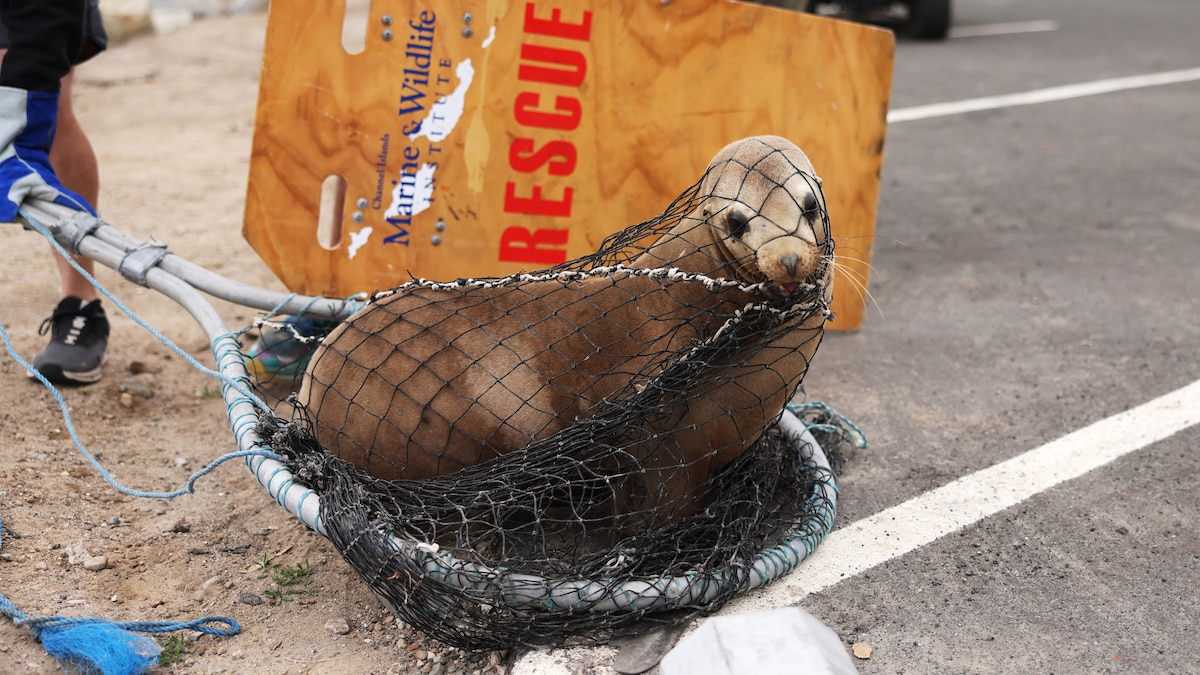Now Reading: California’s sea lions aren’t really ‘demonic’—they’ve been poisoned
-
01
California’s sea lions aren’t really ‘demonic’—they’ve been poisoned
California’s sea lions aren’t really ‘demonic’—they’ve been poisoned

RJ LaMendola, a 40-year-old photographer, was surfing north of Los Angeles last month when a sea lion charged at him and bit his backside through his wetsuit. The sea lion stalked LaMendola as he desperately tried to paddle to shore, keeping the board between himself and the animal.
“I don’t know how to describe the fear that gripped me at that moment, staring into the face of this creature that looked like nothing I’d ever seen—its expression was feral, almost demonic, devoid of the curiosity or playfulness I’d always associated with sea lions,” LaMendola says.
Still, LaMendola was lucky. The bite was deep and painful, but it didn’t hit “an artery, my face, or something worse,” he says.
He called to report the attack to the Channel Islands Marine Wildlife Institute, which is when he learned that a harmful algal bloom is sickening hundreds of marine animals, including California sea lions and long-beaked common dolphins, leading to permanent brain damage and even death. Neurotoxins in algae can cause behavioral changes, and they’re likely the reason why a formerly friendly presence at sea had turned ferocious.
“I truly care deeply about the ocean and its animals above all else,” LaMendola wrote to National Geographic while sitting in the emergency department. He added on social media: “I’ve spent my life advocating for the ocean through my photography. Right now, I’m terrified…for the ocean and its inhabitants. Something’s wrong.”
LaMendola’s worries align with reports from California officials, who say they are receiving up to a hundred calls per day from concerned citizens about sick sea lions and dolphins. And in late March, a 15-year-old girl was bitten by a sea lion in Long Beach, California; she was bruised but is now recovering.
Why a sea lion would attack a human
California sea lions are a success story of 1972’s Marine Mammal Protection Act. In the late 1920s, no more than 1,500 sea lions were counted on the California coast. Today, about 250,000 sea lions live in the area, and they’re generally a friendly presence. Attacks—especially unprovoked, as were the two recent cases—are exceptionally rare.
But the coast of Southern California is currently experiencing a harmful algal bloom from an organism called Pseudo-nitzschia, a type of diatom—a tiny, single-celled algae that floats in the water. Diatoms are important for marine ecosystems because they form the base of the food chain, providing nutrients for small marine creatures like plankton, which are eaten by fish and other animals.
The problem is that they can release a potent neurotoxin called domoic acid. Like other types of algae, Pseudo-nitzschia is always in the water. However, under the right conditions, it can rapidly grow and release the toxin, says Clarissa Anderson, a biological oceanographer at the Scripps Institution of Oceanography in La Jolla, California.
“The juice you need to fuel these blooms is upwelling,” says Anderson, referring to the natural ocean process where deep, cold, nutrient-rich water rises to the surface along the coast, due to the movement of ocean currents and winds, particularly during the spring and summer. “It’s a perfect recipe for stimulating algae blooms.”
The reason why is “tricky,” Anderson says. One hypothesis is related to nutrient composition in the upwelled water, which is low in silica and high in nitrogen. The Pseudo-nitzschia may not have enough silica to make its shells (glass-like outer casings), and that stresses it out, producing domoic acid, according to Anderson. “It’s complicated as to why, but that’s been a smoking gun for us, the ratio of those two nutrients.”
In addition to the upwelling, scientists are exploring other causes for the blooms, like the January wildfires along the California coast that warmed the ocean and added nutrients.
You May Also Like
The bloom has periodically appeared on the West Coast since 1991, but 2025 is the fourth consecutive year for the harmful algal bloom, suggesting it may become a regular occurrence. The toxic algae emerged earlier than it has in previous years, and so far, it has stretched about 370 miles, from San Diego County to Santa Barbara County.
How neurotoxins harm animals
Sea lions affected by domoic acid show signs of illness like head-bobbing or seizures. Kathi Lefebvre, a research biologist with NOAA fisheries, who has been studying domoic acid in marine mammals since 1998, explains that the toxin overstimulates the nerves in these animals.
Domoic acid has a structure similar to glutamate, a neurotransmitter that naturally signals between nerve cells in the central nervous system, helping nerves to fire, Lefebvre says. When domoic acid binds to the receptors, it stays there longer than glutamate would, triggering the concerning behavior.
The neurotoxin domoic acid makes its way into marine mammals through the food chain. Filter-feeding fish, like anchovies and shellfish, consume the algae that produce the toxin and absorb it into their bodies. When larger animals like sea lions, dolphins, and even humans eat these contaminated fish or shellfish, they too ingest the toxin. (It can be fatal to humans in high doses.)
Even chronic, low-level exposure can impact an animal. “If you stimulate a sea lion that has long-term, low-level exposure, their reactions are going to be greater, exacerbated,” she says.
This is why the sea lion may have attacked LaMendola, if the animal was suddenly startled by his presence. Lefebvre points out that while the toxin causes overreactions in sea lions, most of these behaviors are triggered by external stimuli, not by the animals actively seeking out something to bite. “If you think about it, it’s kind of sad,” she says, reflecting on how surfers used to be able to coexist safely with these animals in the ocean.
Most experts agree that bites, however, are very rare and that beachgoers generally should not be concerned.
“We do not have a good way of tracking [sea lion bites],” says Michael Milstein, the public affairs officer for NOAA Fisheries. Whether there are more bites during domoic acid events is also hard to say. “Anecdotally, we have heard about more of these still-very-rare incidents, but we really do not have reliable enough statistics from year to year to identify a consistent trend.”
The 15-year-old bitten in late March had been completing a swimming test for a lifeguard program when she felt something grip her arm in the water. Although she was bitten, she walked away without any serious injuries.
Can these animals be saved?
A sea lion with enough toxins to cause seizures and brain damage will never fully recover, says Lefebvre—even if it is treated. “They are impacted forever,” she notes, as the toxin impairs memory, making it difficult for sea lions to navigate or find food. With low-level exposure—meaning that the animal has experienced no seizures—memory deficits may occur over time but go away after exposure ends, she adds, pointing to testing in a laboratory mouse model.
Sharon Melin, a biologist with NOAA Fisheries, explains that domoic acid events can cause pregnant sea lions to miscarry and can lead to deaths at sea, though it’s difficult to measure the exact impact. If fewer pups are born, domoic acid could be a contributing factor, but other factors also influence sea lion birth rates.
The other main species affected is the long-beaked common dolphin, but population-level impacts for this species are not expected, even though there is little that scientists can do for stranded dolphins.
However, several NOAA-authorized rehabilitation centers have been responding to dozens of calls a day for sea lions coming ashore because of the toxin. They’re working to save as many animals as they can, while also collecting valuable data for ongoing research on the effects of domoic acid and its impact on marine life. But even if animals are returned to the wild, their memory is still affected, and many can’t navigate their environment as well.
Jeff Bohem, of the Marine Mammal Center, emphasizes that while it’s natural for beachgoers to be curious, animals on the beach could be sick, and human interaction only adds to their distress. He urges people to stay at least 150 feet away and notes that trying to force the animal back into the water could worsen its condition and complicate rescue efforts. “Unpredictability in a sick animal is probably greater because they’re neurologically ill,” he says. “Their actions are not something that we can predict easily.”























